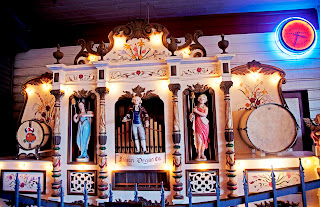You know about the state flower, and maybe even the state tree, but did you know California has a state fossil??
It's the saber-toothed cat… discovered right here in the Tar Pits of Los Angeles…!
Millions of years ago, during the Miocene Era, the Los Angeles area was an ocean basin. Today, this area is in the middle of downtown, and even though it is known as the Tar Pits, you won't find any 'tar' there - the dark, sticky substance responsible for so many trapped animals is actually asphalt, or low grade crude oil. Over the centuries, the marine plankton that died here became the large petroleum reservoir known as Rancho La Brea (Tar Ranch). This crude oil bubbles up from deep in the earth, and the lighter components evaporate off, leaving the heavy, tar-like substance. Anything falling into these pits, known as seeps, gets hopelessly trapped, and lucky for us, very well preserved. Hence, the La Brea Pits are one of the richest deposits of Ice Age fossils in the world.
Millions of years ago, during the Miocene Era, the Los Angeles area was an ocean basin. Today, this area is in the middle of downtown, and even though it is known as the Tar Pits, you won't find any 'tar' there - the dark, sticky substance responsible for so many trapped animals is actually asphalt, or low grade crude oil. Over the centuries, the marine plankton that died here became the large petroleum reservoir known as Rancho La Brea (Tar Ranch). This crude oil bubbles up from deep in the earth, and the lighter components evaporate off, leaving the heavy, tar-like substance. Anything falling into these pits, known as seeps, gets hopelessly trapped, and lucky for us, very well preserved. Hence, the La Brea Pits are one of the richest deposits of Ice Age fossils in the world.
These seeps have been trapping local animal and plant life for over 50,000 years, and so most of the fossils recovered have been from the Pleistocene, between 40,000 and 8,000 years ago. Due to this, the Page museum is home to most of the world's best Pleistocene vertebrate assemblages, also known as a Lagerstätten (site), which means they are exceptional either in the quality of preservation or in the quantity of fossils.
From these plant and animal remains we can tell that life in the Los Angeles basin was cooler and wetter during that time period, however, many of the plants and animals found in La Brea are almost identical to current native species. A large number, though, fall within the 'extinct' category : camels, mammoths, mastodons, saber-toothed cats, and more. Also, an unusually high proportion of the fossil finds in La Brea are carnivores.
Over 100 pits have been excavated in the site, producing over 600 species and over one million fossil bones! Visitors can see remains of Ice Age fossils, and can also observe active seeps, which occur not only in Hancock park itself, but, for several blocks in the area. The asphalt seeps up onto streets, into sewers, and under buildings, so beware! The bubbling asphalt seeps still trap many types of animals (and the occasional person!), especially during warm days when the asphalt is stickiest.
One of their newest and best sites, Project 23, happened because in 2006, the nearby Los Angeles County Museum of Art (LACMA) began work on a new underground parking garage. While digging, 16 new fossil deposits were discovered, including the mostly complete skeleton of an adult mammoth.
One of their newest and best sites, Project 23, happened because in 2006, the nearby Los Angeles County Museum of Art (LACMA) began work on a new underground parking garage. While digging, 16 new fossil deposits were discovered, including the mostly complete skeleton of an adult mammoth.
It was called project 23 because 23 boxes of material were saved from the construction's destruction. They were moved to the Pit 91 area for study, along with 327 more buckets of fossil material for Page employees to clean and sort through, which should take a while…
Southern California isn't the only place in the world with Tar pits… but that is another story for another blog…
See the rest of my photos here:
https://www.facebook.com/media/set/?set=a.301474443289346.49752.100002803789126&type=3
For more information, please go to:
http://www.tarpits.org
http://www.geoworld.org/California/Prehistory
http://www.ucmp.berkeley.edu/mammal/carnivora/sabretooth.html
http://www.sci-news.com/paleontology/tibet-a-homeland-for-ice-age-giants.html
http://www.statesymbolsusa.org/California/fossil_sabre_tooth.html





















